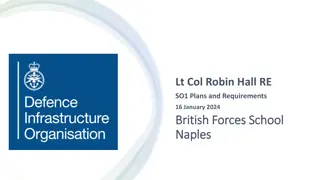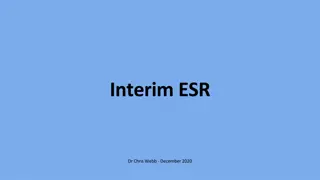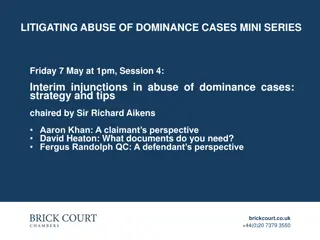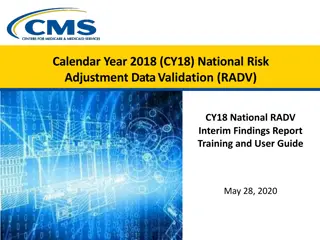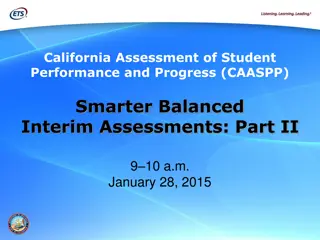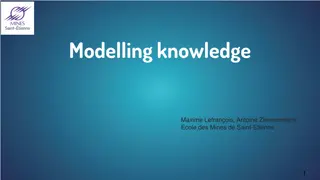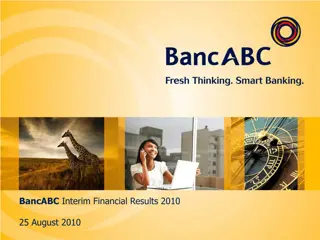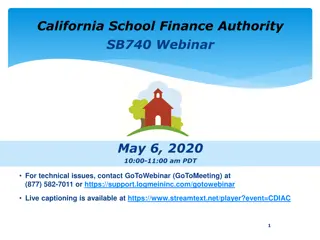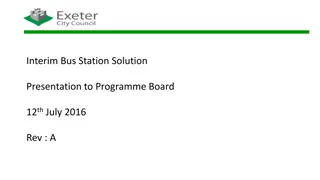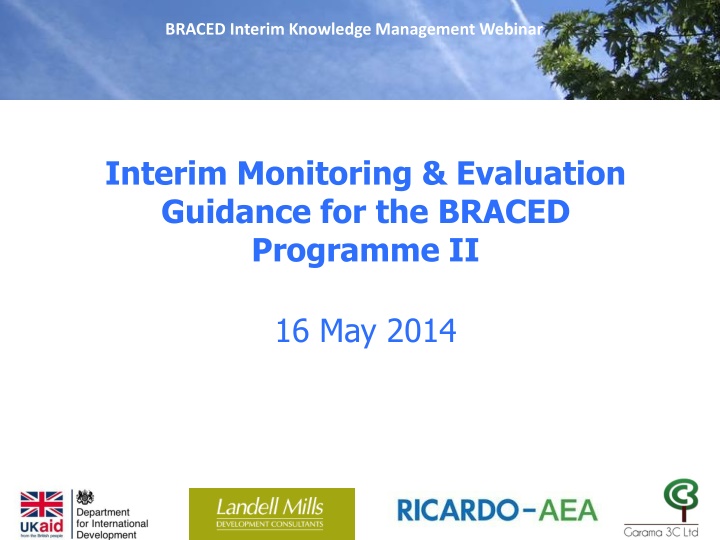
BRACED Interim Knowledge Management Webinar
A webinar held in May 2014 for BRACED Programme II grantees to address key M&E questions, update on emerging guidance, explore methodological issues, and present M&E standards. Updates on guidance availability and KPI measurement discussed."
Download Presentation

Please find below an Image/Link to download the presentation.
The content on the website is provided AS IS for your information and personal use only. It may not be sold, licensed, or shared on other websites without obtaining consent from the author. If you encounter any issues during the download, it is possible that the publisher has removed the file from their server.
You are allowed to download the files provided on this website for personal or commercial use, subject to the condition that they are used lawfully. All files are the property of their respective owners.
The content on the website is provided AS IS for your information and personal use only. It may not be sold, licensed, or shared on other websites without obtaining consent from the author.
E N D
Presentation Transcript
BRACED Interim Knowledge Management Webinar Interim Monitoring & Evaluation Guidance for the BRACED Programme II 16 May 2014
Purpose of the second webinar To address key questions from Grantees submitted after the first webinar To update Grantees on status of emerging guidance To explore key methodological issues in more detail To present draft Bronze, Silver, Gold standards for key aspects of project- level M&E ( M&E Standards )
Content of webinar 1. Update on emerging guidance 2. Measuring KPI1 numbers supported 3. Collecting and using climate and related data 4. Construction and using resilience indicators (KPI4) 5. Attributing changes in resilience to project activities (KPI4) 6. Use of control groups in attribution 7. Report from Concern on Crisis Resilience Indexing System
Guidance available in May 2014 1. Methodological guidance for all 15 KPIs (note KPI4 being revised below) Full set to be shared with grantees ASAP 2. Additional guidance on definition of direct beneficiaries BRACED website complements guidance to KPI1 (1 above) 3. Revised KPI4 guidance In development available on BRACED website by end of May 4. Measuring Resilience report Final version to be on BRACED website before end of May 5. Revised log-frame Next iteration to be published on website shortly 6. Programme monitoring plan In development to be circulated by end of May 7. Value for Money for Adaptation framework Flyer will be on BRACED website next week, full version following week (end of May)
2. Measuring KPI 1 numbers supported Martin Whiteside 6
KPI 1 - Number of people supported by DFID programmes to cope with the effects of climate change Q Is the number of people supported in the BRACED logframe (KPI 1) the same as our direct or indirect beneficiaries? Measuring an reporting KPI 1 is mandatory for all projects; Need consistency Check definitions in KPI 1 guidance notes Different projects/organisations have different definitions of Direct and Indirect beneficiaries for KPI 1 reporting need to use KPI 1 definitions that are specific to BRACED (see the BRACED website); Report number of individuals disaggregated by gender (can be calculated from HH numbers as long as clear whole family are supported; Counted and reported annually
DEFINITIONS KPI 1 - Number of people supported by DFID programmes to cope with the effects of climate change Support - direct assistance from the programme in question, with the explicit intention of helping people deal with climate change impacts. It could include for example financial resources, assets, agricultural inputs, training, communications (e.g. early warning systems) or information (e.g. weather forecasting). People supported - identified by the programme in question with a direct relationship to it. Effects of climate change - existing and future, sudden or gradual, arising from primary consequences of CC (changes to precipitation, temperature and sea level rise) - can include floods, droughts, storms, landslides, salination, coastal inundation, heat or cold waves and biodiversity loss.
Categories for reporting KPI 1 - Number of people supported by DFID programmes to cope with the effects of climate change BRACED DIRECT A High intensity Both targeted and high intensity e.g. people receiving social protection cash transfers, houses raised on plinths, agricultural extension services, training of individuals in communities to develop emergency plans and use early warning systems. B Medium Intensity i) Targeted & Medium intensity: e.g. people receiving weather information and text message early warnings. ii) Not targeted & Medium intensity: e.g. people within the coverage of an early warning system, or catchment area of a large infrastructure project (e.g. flood defences), or living in a discrete community in which others have been trained in emergency response BRACED INDIRECT This does not contribute to the KPI 1 headline figure, but can be reported separately C Low intensity: e.g. people falling within an administrative area of an institution receiving capacity building support, or catchment area of a Water Resources Management plan (can be captured through the programme s own monitoring, or institutional development scorecard).
3. Collecting & using climate data Martin Whiteside 11
Collecting Shock and Stress (S&S) Data Q - How should we collect climate shocks/trend data, and how technical and detailed should it be? Key concepts: Concentrate on S&S being addressed by your project Base focus on S&S as experienced by your target beneficiaries; Triangulate against S&S relevant scientific data
S&S Data - STEPS Planning Phase 1. Define the S&Ss your project is building resilience against; 2. Participatory enquiry for each S&S: Beneficiary prioritisation of different S&S (understand differences) Severity category for main S&Ss v. severe; severe, normal, good? Ground truth against known years/events in past 3. Historic agri/met/hydro/well-being scientific data e.g. crop prod., rainfall, flood levels, deaths from disaster Reliability, specificity, relevance 4. Triangulation Relevance to community experience of S&S (e.g. days without rain in growing season may be more important than monthly rainfall) Data gaps can we fill in implementation? Correlation between community perception and scientific data? 5. Trend What trends can be discerned? (Across perception and measured?) What are implications?
S&S monitoring - Draft Standards Bronze Silver Gold Definition of shocks and stresses (S&S) S&S identified and described by programme staff or key informants Staff/key informant identification of S&S supplemented by beneficiary information on priority and characterisation Data relevant to some of the key shocks/stresses, reasonably congruent with project area and with fair reliability. Limited supplementary primary data collection. Ranking disaggregated by key S&S and beneficiary type and or geographical area. Each Shock or Stress prioritised and defined through participatory approaches across range of beneficiary types and contexts, ground truthed against specific events and years. Relevant, reliable, geographically specific data covering most of key S&S, disaggregated if necessary across key zones of project area. Supplementary primary data collection organized as needed. Ranking disaggregated by S&S and beneficiary type and or geographical area. Clear participant explanation for each ranking and comparison with previous similar years/events. Significant correlation. Scientific data collection Limited secondary data (e.g. mm rain/year) and/or not very congruent with project area or sub-areas and/or with doubts on reliability Limited ranking of very severe, severe, normal and good for year. Community shock and stress perception monitoring Triangulatio n Trend data Little possible Some correlation identified. Weak - scientific data of limited reliability, specificity and relevance supplemented by anecdotal views; Little Moderate reasonably reliable, specific and relevant scientific data correlated in some cases with community perceptions Strong - reliable, specific and relevant scientific data correlated cases with community perceptions Learning Significant Very significant
S&S Data - STEPS Implementation Phase 6. Beneficiary S&S perception monitoring participatory, clear criteria (can include questions on how project outputs have affected these) 7. Agri/met/hydro/well-being scientific data - collect Relevant to S&S May need to supplement/re-format/analyse/interpret 8. Triangulation annual/event Use of information - learning Beneficiary S&S priorities and experiences during project, Contextualising project outputs and outcomes did these address felt S&Ss? Deepening understanding of relationship between scientifically measured and experienced S&Ss Enabling explanatory correlation between resilience outcomes and well-being impact Additional understanding of trends Feed into continual project improvement.
4. Constructing & using resilience indicators Nick Brooks 17
What should resilience indicators measure? Factors/attributes we think will make people better able to anticipate, avoid, plan for, cope with, recover from & adapt to stresses & shocks These will be context-specific & should be identified during development or early in implementation phase through, e.g. participatory assessments Factors/attributes to be measured are those that will/may be influenced directly or indirectly by the project (positively or negative potential for unintended consequences) Other factors/attributes identified as important for resilience but that are not related to project activities should be noted these might be tracked to provide context, but will not contribute to calculation of numbers with improved resilience for reporting against KPI4
Resilience outcomes & project outputs Resilience measured at outcome level in BRACED log-frame Changes in resilience usually measured as project outcomes Two broad types of resilience outcome indicator: 1. Indicators that measure numbers of people sustainably adopting project outputs essentially measures of uptake of project outputs, where there is good evidence that this ill improve people s resilience (uptake indicators) 2. Indicators that measure changes in factors/attributes/status that we believe (based on evidence) will make people more resilient that are not tied to project outputs & may be measured for non-beneficiaries (status indicators) Ideally, project will complement (1) with (2)
Types of indicators Qualitative, e.g. based on beneficiary perceptions of how easily they can cope with particular stresses/shocks, access resources that make them more resilient, etc. Quantitative binary, e.g. value of 0 for no & 1 for yes in answer to certain questions (e.g. does beneficiary have access to certain resource, meet a certain criterion that is important for resilience?) Quantitative categorical/score based, e.g. assign score based on category of resilience as measured by a particular indicator (low, moderate, high, etc.) Qualitative indicators can be converted to quantitative score-based indicators Quantitative continuous, e.g. based on measurement of a continuous variable such as household income, time to recover from previous shocks. Projects likely to employ a mixture of the above
Composite & individual indicators Projects might use: 1. A number of individual indicators, each representing a different aspect of resilience as relevant to the project Measure changes in each indicator separately for individuals sampled 2. Several composite indices, each representing a different dimensionof resilience as relevant to the project: e.g. income & food access; safety nets, access to services, adaptive capacity, etc Guidance on dimensions under KPI4, but not prescriptive 3. A single composite index, representing resilience as relevant to the project Judge whether such aggregation appropriate based on nature of indicators Project might measure only one dimension of resilience (cf (2))
Construction of composite indicators How to aggregate different types of indicator? Need to convert to common format, e.g. using: Discreet scores: Split range of continuous variables into divisions, with each division represented by a score, e.g. 1-3, 1-5; Define categorical indicators using same scoring system Add binary indicators (e.g. 3 or 5 indicators for same range as above) Scaled values: e.g. from 0-1 Add values together or take average across values Need to consider weights Assign to constituent indicators based on relative importance Usually done subjectively, not straightforward These issues are less pressing (although not necessarily irrelevant) for individual, disaggregated indicators
Numbers with improved resilience For panel data/ longitudinal studies (sampling same individuals) Single composite index No. showing increase in index value minus no. showing decreased resilience Multiple composite indices No. showing improvement in 1 or more indices (and no decreases) minus no. showing decreased resilience in 1 or more indices (and no increases) Multiple disaggregated indices a) For improved resilience , require a minimum number (X) of indicators to show improvement, and a maximum number (Y) to show deterioration. X and Y to be set according to context, with X > Y Might need to demonstrate improvement in a set of core related indicators b) Vice versa for decreased resilience c) Number with improved resilience is number fulfilling (a) minus (b) Scale up from sample to beneficiary population, ensuring sufficient sample size and considering disaggregation (take statistical advice)
Numbers with improved resilience Where sampling does not involve the same individuals each time Define a threshold for improved resilience, based on e.g. Movement out of low resilience category, to moderate or high For disaggregated indicators need to decide how categories constructed Minimum value of a composite index Sample at different periods Baseline data gathering period t0 Subsequent sampling periods t1 , t2 tn-1 , tn Number with improved resilience is: No. in lowest resilience category at tn-1 minus number in this category at tn No. above resilience threshold at tn minus no. above threshold at tn-1 Sampling methodologies (e.g. panel survey or samples using different beneficiaries) will have implications for how indicators are constructed
Resilience indicators Draft Standards Bronze Silver Gold No. with improved resilience, based on no. adopting project outputs, no. moving out of lower resilience category, or no. crossing res. threshold As Bronze, plus additional data on changes in numbers in multiple categories (e.g. low, med., high resilience) panel data or other sampling As Bronze plus one or more of: beneficiary perception-based indicators - better/worse than before; low, med., high for different aspects of res. More objective criteria for different levels of resilience or position with respect to resilience threshold As Bronze, plus additional data on how much resilience has improved based on sampling of same individuals Counting method (KPI4) Mix of uptake, perception- based & objective indicators, with objective indicators based on more detailed categories and/or continuous variables. Assessment of consistency across different indicators Indicators measuring uptake of project outputs supported by evidence that this improves resilience (can include indirect beneficiaries where uptake beyond direct beneficiaries, e.g. emulation) Type of indicator During implementation; 1 ex- post measurement; During implementation; 1 ex-post measurements Timing Baseline and end As Silver plus correlation of indicators with losses for past stresses & shocks Evidence base for indicators Qualitative evidence based on beneficiary feedback & good theory of change As Bronze plus case study evidence from past stresses and shocks Disaggreg- ation Gender + other pre-determined classes Gender + other pre- determined classes Gender
5. Attributing changes in resilience to project activities Nick Brooks 27
Attribution vs. Contribution Grantees (& DFID) want to determine whether (and to what extent) the intervention is making a difference Attribution: Determining the degree to which the projects are causing the observed resilience outcomes (and measured well-being impacts); Contribution: Determining the degree to which the projects are contributing to or helping to achieve the observed resilience outcomes (and impacts); In practice this distinction not critical projects will ask: Are resilience & well-being (as measured by indicators) changing? To what extent is the project responsible for these measured changes? To what extent can we say project contributed to or caused these changes? If evidence suggests changes would not have happened without the project, we can attribute changes to project; if evidence suggests project played a role but was not sole driver, we can say project contributed to changes In practice there will be a continuum from no contribution to full attribution
How much of improved resilience is due to project? No. with improved resilience no. with improved resilience due to project support Assess using Beneficiary feedback (qualitative explanatory enquiry) Build questions on where/extent to which project helped build resilience into surveys used to gather data for resilience indicators (panel & other survey) Narratives from beneficiaries (panel survey: compare narratives over time) Comparisons of resilience (as represented using indicators) Before & after intervention Between groups at different stages of a phased intervention Between beneficiaries and comparison/control groups Comparison/control groups must have similar characteristics (e.g. livelihoods, economic/policy contexts) and be exposed to similar/same hazards
Characterising contribution Qualitative description of contribution If X people have improved resilience, and there is good evidence* that project played a role, can say project contributed to improved resilience of X people * e.g. demonstrable differences between project area and other similar areas coupled with feedback from key informants indicating project played significant role in these differences; resilience outcomes match theory of change and no other plausible explanations; etc. How much did project contribute, and how did this vary across different groups? Quantification of contribution Beneficiary perceptions from surveys what proportion (X) of sample representing beneficiary population N, say project contributed? Number with improved resilience due to project = X*N Can also ask in what ways project contributed, and by how much (a little, a lot, etc.) Difference in difference 1 - what proportion of people are more resilient in sample of beneficiary population (X) than in sample of control population (Y)? Number with improved resilience due to project = (X-Y)*N Need large, representative samples seek statistical advice 1As described by Khan and Anderson (2014): http://www.iied.org/climate-adaptation-good-development-two-sides-same-coin
Attribution/contribution Draft Standards Bronze Silver Gold As Bronze, but informed by questions related to role of project built into surveys of beneficiaries. Include those excluded from benefit. Use of phased intervention approach to compare beneficiaries at different stages of intervention through panel survey. Qualitative description of extent to which project contributed, e.g. one of several factors, significant or major (but not sole) factor, resilience would not have been improved without project; describe for different groups of beneficiaries. Project level estimate of contribution of project based on combination of qualitative and quantitative reasoning. As Silver, but also informed by beneficiary narratives derived from panel studies. Include those excluded from benefit. Qualitative explanatory enquiry Use of control/comparison groups exposed to similar/same stresses & shocks. Counterfactual Before/after intervention. Assessment of contribution Project contributed to improved resilience of X number of people. Quantitative characterisation that indicates the % of the total numbers with improved resilience that can be attributed to the project and/or the degree of change that can be attributed to the project. 31
6. Use of control groups in attribution or contribution Nidhi Mittal 33
Role of Control Groups Role of control groups in measuring attribution or contribution The evaluation framework, including data sources/methods depends on whether the focus is on attribution or contribution. Attribution analysis will require more experimental type evaluations: Use of experiment (and control groups) tries to isolate one factor the receipt of an intervention or a project , everything else being constant. Individual households or communities are randomly assigned to the control group (randomised control trials). Quasi experiments similar groups of beneficiaries, or communities are used to create comparison groups ( no randomisation involved) Contribution analysis can be more theory-based and supported by a broader range of methods and sources of data to develop a consistent narrative. Quasi experiments, case studies, correlation studies, longitudinal studies, and sample surveys 34
Effective use of Control Groups Beyond KPI4: using control groups to assess resilience impacts Use of control groups can be extended beyond measuring KPI 4. The approaches for assessing improved resilience outcomes are broadly applicable to assessing resilience impact indicators (e.g. well-being indicators , loss and damage). Stakeholder discussions: Engaging with stakeholders to ensure that the methods used are feasible, realistic, and responsive to needs, and appropriate to the intervention. Seeking expert advice to identify the types of questions to be asked, understanding fully the risks of leading questions. Ethical challenges and limitations of using control groups There are ethical questions on how/when to use control groups When an actor interacts with beneficiaries, they expect certain actions. Managing expectations and helping beneficiary groups understand the value and challenges of contribution and attribution is key. DFID s Ethics Principles for Research and Evaluation (2011) provides further guidance in relation to ethical use of control groups. 35
Support Available from Interim and full KM Planning future KM support on control groups Projects should be aiming to deliver their M&E plans as described in the concept notes and whereby they have planned or are planning to use control groups, they should flag support needs to the KM. Although encouraged, control groups are optional as a (gold standard) measure and not mandatory if projects did not originally plan this in their concepts. Guidance from the interim KM The KPI4 guidance from the interim KM will provide some over-arching principles of using control groups for measuring attribution of resilience outcomes or the contribution to resilience of beneficiaries. Brief telephone or email consultations/review of approaches to M&E project leads can be provided by the interim KM to the grantees. 36
Support Available from Interim and full KM Planning full KM support The full scope of the guidance and support from the KM cannot be finalised until the permanent KM is in place, the final projects are chosen and resourcing needs overall are assessed. It is likely to be a flexible and iterative process when the full KM pulls together the BRACED monitoring and evaluation approach overall on the basis of the final list of project s M&E frameworks. Information needed from grantees to plan future KM support Projects should indicate whether they are planning to use control groups and which standard(bronze, silver, gold) best reflects their M&E approach. This information should be submitted to the interim KM within the Bronze, Silver, Gold grading standards template to be shared by end May. The interim KM will use this scoping assessment to map projects on the grading standards scale , assess their support needs and inform the tailored support plan for the full KM to provide to the grantees. 37
6. Concerns Crisis Resilience Indexing System Aine Magee 39
Community Resilience Indexing System (CRIS) Aine Magee- Concern M & E Adviser
Measuring Resilience Due to difficulties posed in measuring resilience, Concern has been developing a Community Resilience Indexing System (CRIS) which evaluates the assumed characteristics of a resilient community and comes up with an overall CRIS score per community. The CRIS score indicates the level of achievement of each community against specific indicators/characteristics. It is assumed that a high score, meaning a community has a lot of the necessary characteristics, is indicative of a resilient community. Concern could test this assumption through BRACED.
Objectives of CRIS The CRIS is designed to provide a semi-qualitative baseline/ endline comparison tool to assess the impact of work in Disaster Risk Reduction and building resilience, and to facilitate on-going monitoring by providing a comprehensive set of indicators that can be tracked over time. The intention is to investigate the correlation between these assumed determinant of resilience and actual resilience through BRACED, as well as in other contexts. We want to test whether the assumed characteristics of resilience (detailed in the CRIS tool) are correlated to communities who bounce back better after a shock. This work will be carried out with input from a research partner.
CRIS indicators The CRIS Score is calculated on the basis of proxy indicators across 6 livelihood asset classes: Political Assets Social Assets Human Assets Financial Assets Physical Assets Natural Assets Each indicator is assigned a score between 1 and 5, where 1 is the lowest level of attainment, and 5 is the highest. An overall weighted score per asset, and per communities is calculated. Indicators have been developed based on DRR/resilience literature and Concern experiences.
Progress to date: Two pilots using CRIS to measure characteristics of resilience have been conducted in Zambia and Sierra Leone. Based on these pilots: the CRIS indicator set is being finalised the methodology for administering the tool is being refined the possibility of developing an app form of the tool for use on laptops, smart phones or tablets is being investigated
CRIS in BRACED Concern hopes to use the revised CRIS tool to measure a related outcome level indicator for BRACED Average Score across target communities on the Community Resilience Indexing System . We would hope to see an increase in the average score throughout the programme indicating in an increase in the resilience characteristics of target communities. The suggestion is that the population in communities who show an increase in resilience characteristics over time, can be included in the measurement of KPI 4: No. of people with improved resilience as a result of BRACED projects
Opportunities for further knowledge sharing If you would like the opportunity to present your own learning regarding M&E tools and methodologies, please let us know via your Monitoring Officer. We would be happy to facilitate another webinar (given sufficient interest) to support the dissemination of your experience. Thank you for your participation in today s webinar. Any further comments or questions should be sent to your Monitoring Officer and we will respond as soon as we are able.


